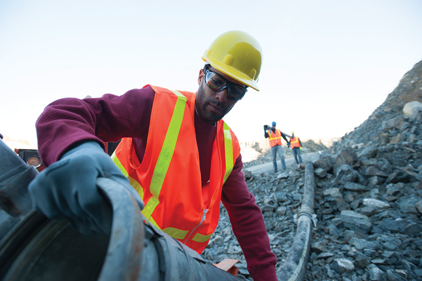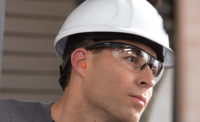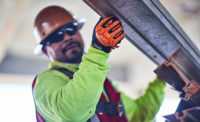In road construction work zones, more than 100 workers are killed and 20,000 workers are injured annually, according to the U.S. Department of Transportation. Safety managers and workers alike should be familiar with the American National Standards Institute/ASSE Standard A10.47-2009: Work Zone Safety for Highway Construction, which applies to everyone engaged in construction, utility work, maintenance or repair activities on any area of a highway.
Given the inherent dangers inside work zones, special attention should be paid to protecting workers’ most valuable assets: their eyes, faces and heads. Otherwise, injuries can result in burns, loss of eyesight, trauma and even death. Every recordable injury impacts productivity, and the toll on employers and individuals alike can be catastrophic. This article provides tips for protecting workers from the neck up in highway work zones.
Protecting the eyes
Numerous hazards to the eyes exist in roadway applications, from airborne debris and chemical splash to intense visible and invisible rays. Injuries resulting from exposure to such hazards can cause temporary or permanent vision impairment and even the loss of an eye. Every individual should be outfitted with protective eyewear that complies with the ANSI Z87.1 standard for impact protection at a minimum. Once hazards are identified, look for eyewear designed to protect from all of them in a single solution.
Safety spectacles offer primary protection from impact and light hazards, and choosing frames with extended wraparound coverage is a good choice for increased protection and improved peripheral vision. While most safety eyewear protects from 99 percent or more of harmful ultraviolet light, only specialized lens tints can protect from overexposure to other types of light hazards such as infrared or glare. Look for lens tints specifically designed for the lighting application to avoid short- and long-term vision loss. Lenses coated with advanced anti-scratch and anti-fog properties are also an important consideration that will lengthen the life of the lens, improve workers’ visual acuity and reduce distractions. Remember, street wear sunglasses are never a safe choice on the job. They are rated neither for the level of impact protection nor the optic clarity required by ANSI Z87.1.
Eyewear that seals to the face offers greater protection where exposure to flying dust and debris or chemical splash hazards exist. While traditional goggles provide such coverage, they can also feel bulky which may lead to their removal. For a streamlined solution, look for a newer entrant to the safety eyewear market: sealed eyewear. A hybrid style that offers the sealed protection of a goggle in the low-profile design of spectacles, sealed eyewear is quickly gaining popularity in the construction, utilities, and oil and gas industries for its versatility, protection and comfort. Whatever style of safety eyewear is employed, be sure to outfit workers with the most effective possible anti-fog lenses to preserve vision when exertion, heat and humidity are likely to cause fogging.
Protecting the face
Roadway work zones abound with hazards that can injure workers’ faces, as well. For high-hazard jobs ranging from cutting steel to mixing concrete, protecting the face is extremely important. Left unprotected, workers can suffer serious injuries above the neck such as burns, lacerations and penetration. For this reason, best practices call for ANSI Z87.1 eye and face protection to be worn when machines or operations present potential injury from physical, chemical or radiation agents.
When selecting a face shield, be sure it meets high impact ANSI Z87.1+ standards and provides ample frontal coverage of the face and neck for the hazards present. To support compliance and proper wear, consider comfort and fit. A face shield should fit snugly like a hard hat, and the primary way to achieve a proper fit is through its suspension, also known as its headgear. Headgear is usually adjustable via a headband for circumference fit as well as a top band for depth. Flexible and shaped headbands tend to offer a more customized fit, and most users find them easier to adjust using a ratcheting system rather than pin locks. The more commonly overlooked adjustment is that of the top band. By setting the band just once prior to making headband adjustments, the user can achieve the proper depth setting and therefore the greatest overall stability. When worn properly, the face shield should be centered over the body for optimal balance, and the suspension should comfortably sit less than one inch above the eyebrows.
Because scratching is the leading reason for face shield replacement, use visors treated with scratch-resistant coatings to ensure optimal visibility and prolong visor life. Similarly, anti-fog coatings are an important solution to preventing obstructed vision. For applications with high heat and/or infrared radiation hazards, select face shield visors in the corresponding lens tint or a reflective coating. Finally, in electrified environments, face shields must meet the proper dielectric rating. Be sure that all PPE including components such as hinges, snaps or other attachments are non-conductive to maintain the overall dielectric rating and prevent a shock hazard.
Protecting the head
Hard hats are a form of PPE commonly used in roadway work and are worn in nearly every application. From flaggers and construction workers to welders, cutters and utility workers, hard hats provide invaluable protection. The proper use of hard hats can protect workers from head injuries ranging from minor bumps to concussions and even severe trauma which can result in death.
When selecting a hard hat, performance should be the top priority. OSHA specifies two levels of protection provided by hard hats. Hats labeled ANSI Type I are intended to protect the wearer against impact to and penetration of the crown only, while ANSI Type II hats protect against both lateral and crown impact. The added protection that Type II caps provide can be lifesaving, and for this reason they are becoming more widely adopted throughout the U.S.
Wearer comfort is the second most important attribute of a hard hat. When caps are uncomfortable, workers are more likely to remove them, even in the presence of hazards. Therefore, look for caps that go on — and stay on — comfortably. A good quality suspension supports proper fit, and those with a higher number of suspension points not only improve wearer comfort, they also spread the energy of impact to reduce the effect on the wearer. For a safe fit and adequate retention, have workers wear the hard hat as snugly as possible.


